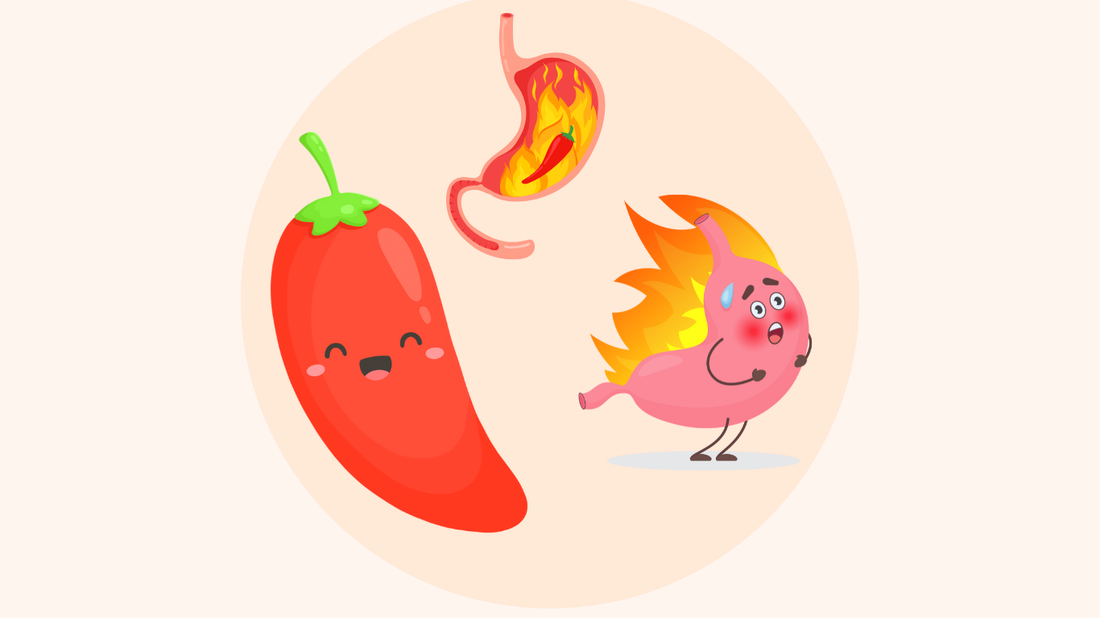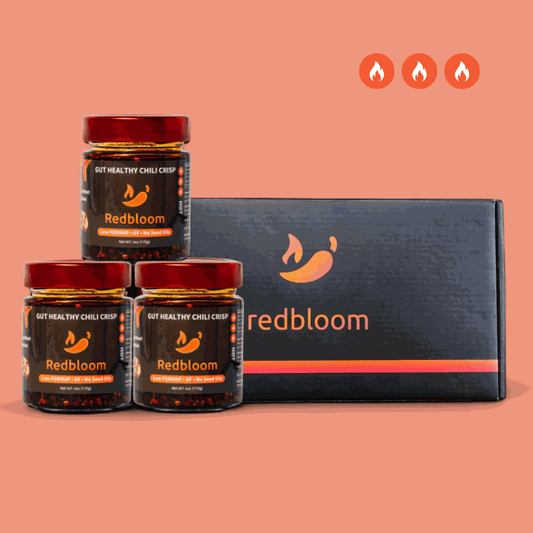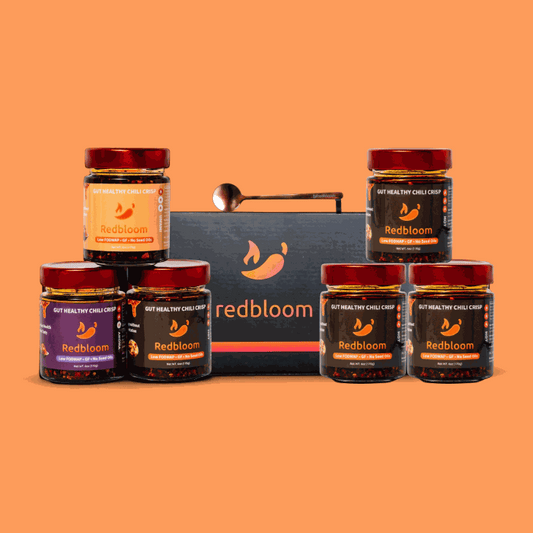Introduction
If you’ve ever felt your stomach react to a spicy meal, you’re not alone. Capsaicin—the compound that gives chili peppers their heat—can have both soothing and stimulating effects on your gut. Emerging research shows that capsaicin interacts with the gut microbiome, influencing inflammation, digestion, and even metabolic health. But as with most things, balance matters.
This article explores what science says about capsaicin’s effects on gut bacteria, inflammation, and stomach comfort. You’ll learn how it can support a healthy microbiome when used mindfully—and how to enjoy chili oil, chili crisp, or spicy foods without upsetting your stomach.
Understanding Capsaicin and the Gut
Capsaicin doesn’t just trigger heat—it also activates receptors in your digestive system that communicate with gut microbes. Studies show that small to moderate amounts of capsaicin can increase the diversity of gut bacteria, which is often linked to better digestion and immune balance [1].
Key Takeaways
-
Moderate capsaicin intake can support a more diverse and balanced gut microbiome [1].
-
Some beneficial bacteria, including those that produce short-chain fatty acids (SCFAs), appear to increase with regular, mild exposure [1].
-
Too much capsaicin may irritate the stomach or disrupt microbial balance, depending on dose and individual sensitivity [2].
How Capsaicin Supports a Healthy Gut
The gut microbiome produces SCFAs—molecules that nourish your intestinal lining and help regulate inflammation. Research suggests that capsaicin may encourage the growth of SCFA-producing bacteria such as Faecalibacterium, which can strengthen the gut barrier and reduce inflammation [1][2].
Why this matters
-
Gut protection: Butyrate, an SCFA, helps maintain the integrity of the gut lining.
-
Inflammation control: A balanced gut can reduce inflammatory signals that contribute to stomach discomfort.
-
Metabolic support: Capsaicin-linked changes in gut bacteria may also play a role in regulating metabolism and energy balance [2].
The Role of Dosage: When Heat Helps (and When It Hurts)
Capsaicin’s effects follow a dose-response curve—meaning a small amount can help, but too much may cause irritation. In studies, low-to-moderate doses of capsaicin were associated with a healthier bacterial balance and reduced gut inflammation, while excessive intake sometimes triggered the opposite [1][2].
Tips for balanced use
-
Start small: If you’re new to spice, begin with a small drizzle of chili oil or a mild hot sauce.
-
Be consistent: Regular but moderate use tends to be more supportive than large, sporadic doses.
-
Listen to your stomach: Everyone’s tolerance is different; discomfort is a sign to scale back.
Inflammation, Comfort, and Gut Resilience
A balanced gut environment helps prevent irritation and bloating. Some evidence suggests capsaicin may reduce certain inflammatory bacteria that produce lipopolysaccharides (LPS)—molecules linked to gut inflammation and discomfort [1].
Simple ways to keep comfort in check
-
Pair spicy foods with fiber-rich sides like rice, beans, or cooked vegetables.
-
Include healthy fats such as avocado or yogurt to buffer the burn.
-
Stay hydrated and avoid eating spicy meals on an empty stomach.
Capsaicin and Metabolic Health: A Gut Connection
In experimental studies, capsaicin has shown potential to support metabolic health by improving gut microbial balance and reducing inflammation caused by high-fat diets [2]. Rather than “boosting metabolism” directly, capsaicin may work by helping the microbiome function more efficiently.
Think of it this way:
-
A healthy gut supports energy balance.
-
Reduced inflammation helps regulate appetite and metabolism.
-
Capsaicin adds a gentle nudge toward these benefits when part of an overall healthy diet.
For Sensitive Stomachs: Enjoying Spice the Gentle Way
If your stomach tends to react strongly to spicy foods, there are still ways to enjoy them comfortably. Adjusting preparation methods and pairings can make a big difference.
Try these adjustments
-
Cook, don’t fry: Choose steamed or broth-based dishes over fried ones to reduce irritation.
-
Buffer with food: Combine spice with fiber, protein, and fat to protect your stomach lining.
-
Choose lighter blends: Opt for chili oils or chili crisps made with neutral oils and fewer raw onions or garlic.
Putting It All Together
Capsaicin can be a helpful ally for gut and stomach health when used thoughtfully. Research points to benefits like improved bacterial diversity, stronger gut barriers, and reduced inflammation—but only at the right doses and within a balanced diet.
Simple reminders:
-
Go slow and observe your comfort level.
-
Combine spice with gut-friendly foods like vegetables, whole grains, and fermented dishes.
-
Remember: more heat doesn’t mean more health.
FAQs
1. Does capsaicin always improve gut health?
Not necessarily. Moderate intake may support gut diversity, but high doses can irritate the stomach or disrupt balance [1][2].
2. Can spicy foods reduce inflammation?
Some studies suggest capsaicin can help reduce inflammation by shifting gut bacteria and lowering harmful LPS activity [1].
3. What’s the link between capsaicin and metabolism?
Capsaicin may influence metabolism through the gut microbiome—helping reduce inflammation and support healthier energy balance [2].
4. I have a sensitive stomach. Should I avoid chili oil?
Not completely—start with very small amounts, pair it with balanced meals, and monitor your body’s response.
5. How can I enjoy spice without discomfort?
Eat spicy foods alongside fiber and fat, avoid overdoing it, and choose milder chili oils with cleaner ingredients.
Conclusion
Capsaicin’s relationship with gut health is both exciting and nuanced. While moderate amounts can promote microbial diversity, strengthen the stomach lining, and ease inflammation, excess heat can do the opposite. The goal isn’t to eliminate spice—it’s to find your personal balance.
When used mindfully, spicy foods can be part of a healthy, vibrant diet that supports both gut comfort and overall wellness.





